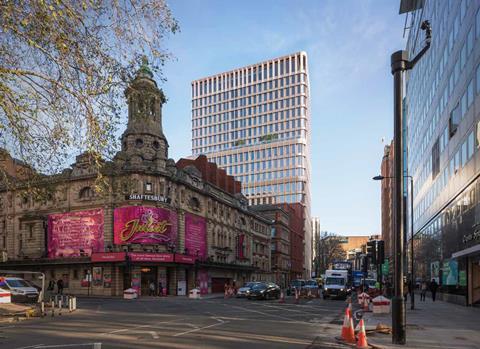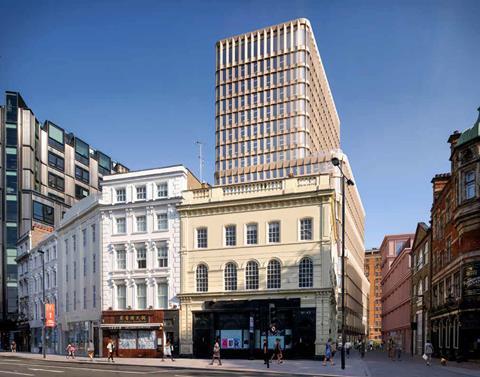Recommendation comes despite opposition from Historic England and Save Britain’s Heritage
Proposals to redevelop a former hotel in Bloomsbury into a mixed-use scheme featuring a 19-storey office tower and 44 homes are being recommended for approval by Camden Council planners.
The proposals, drawn up by DSDHA for client BC Partners, are the third incarnation of the One Museum Street scheme, earmarked to replace a 17-storey former Travelodge hotel and car park – as well as other nearby buildings – in the Bloomsbury Conservation Area.
The plans include 22,650 sq of office space in the tower, while a trio of six-storey buildings and a single five-storey building would include new homes and retail.

DSDHA’s earlier One Museum Street proposals were originally lodged in 2021 and featured a 21-storey tower at the junction of High Holborn and Museum Street, where the 1960s-designed former Travelodge currently stands.
But the scheme attracted criticism from government heritage adviser Historic England, which said the tower would have a “major, harmful impact” on the Bloomsbury Conservation Area and “exacerbate the incongruous backdrop” already created by the 1960s hotel building, named Selkirk House.
Historic England still objects to the latest proposals because of harm to designated heritage assets and the tower’s impact on and longer-range views. The Georgian Group and the Victorian Society also oppose the latest version of the plans.
Save Britain’s Heritage objects to the proposals because of the impact of the tower element – which is 20m higher than the existing tower – and also what it described as the scheme’s “substantially harmful and disproportionate” carbon cost.

But recommending the DSDHA proposals for approval, Camden Council planning officers acknowledged concerns about the scheme’s impact on views and nearby historic buildings – as well as their environmental impact.
However they said the harm would be “less than substantial” in the language of the government’s National Planning Policy Framework, and that scheme’s benefits outweighed the identified harms.
Officers added that consideration had been given to a requirement for the existing Selkirk House buildings – which were once the national headquarters of hotel group Trusthouse Forte – to be reused.
They said substantial works would be required to bring the building up to modern hotel standards and that comprehensive redevelopment – except for the building’s basements, which are being retained for the DSDHA scheme – was “the most efficient use” of the land.
Others working on the scheme include development manager Simten, project manager and cost manager Gardiner & Theobald and structural engineer Heyne Tillett Steel.
A decision is due tomorrow night with the ruling referred to London mayor Sadiq Khan because of the scale of the development.



























No comments yet